Nvidia GeForce GTX 1080 Ti 11GB Review
Nvidia's GeForce GTX 1080 Ti is now the fastest graphics card available, and at $500 cheaper than the previous champ! Should you buy now, or wait for AMD's Vega?
Why you can trust Tom's Hardware
Ashes, Battlefield 1 & Civilization VI
Ashes of the Singularity (DX12)
In the past, we tested Ashes of the Singularity using the game’s Extreme preset. This time around we bumped up to Crazy, given the GeForce GTX 1080 Ti’s forgone position in the performance hierarchy.
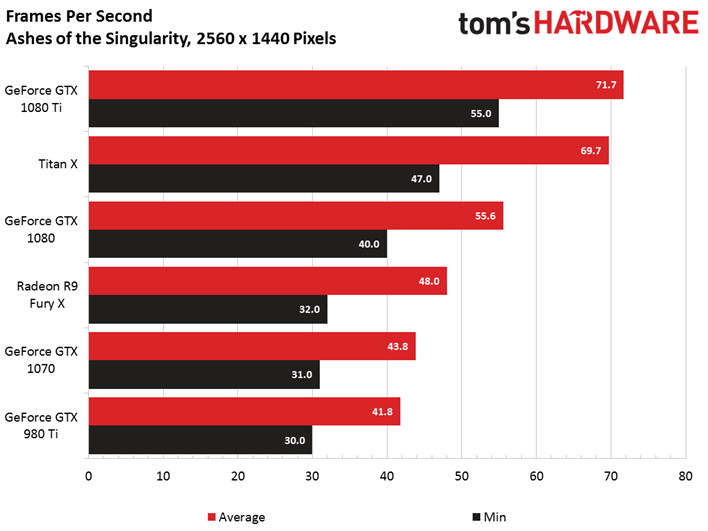
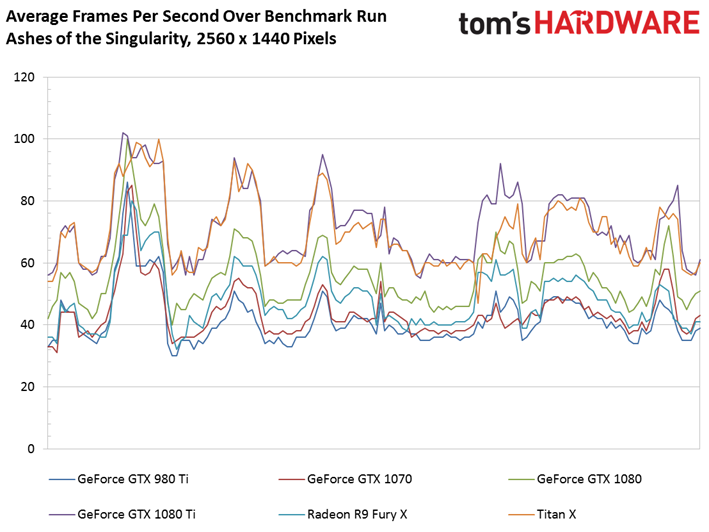
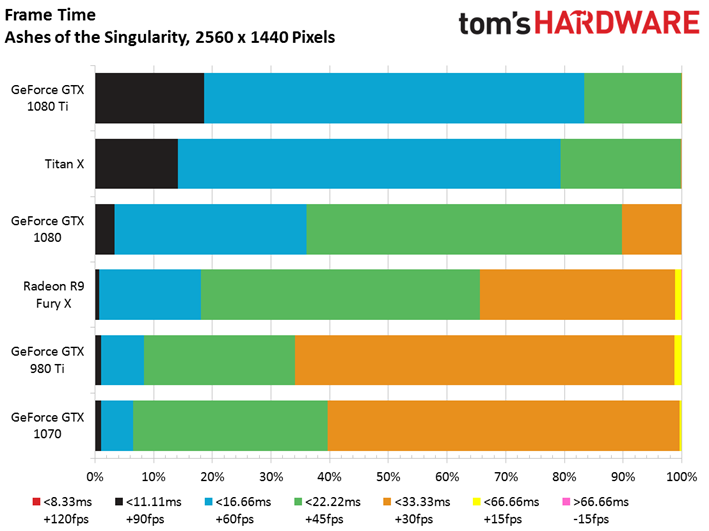
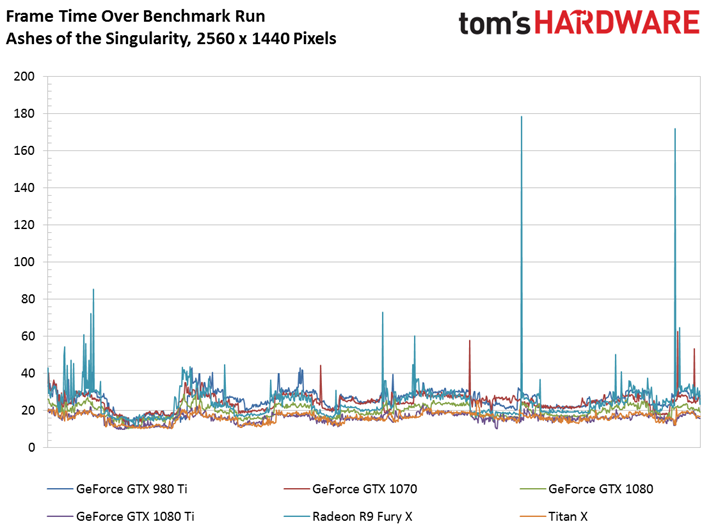
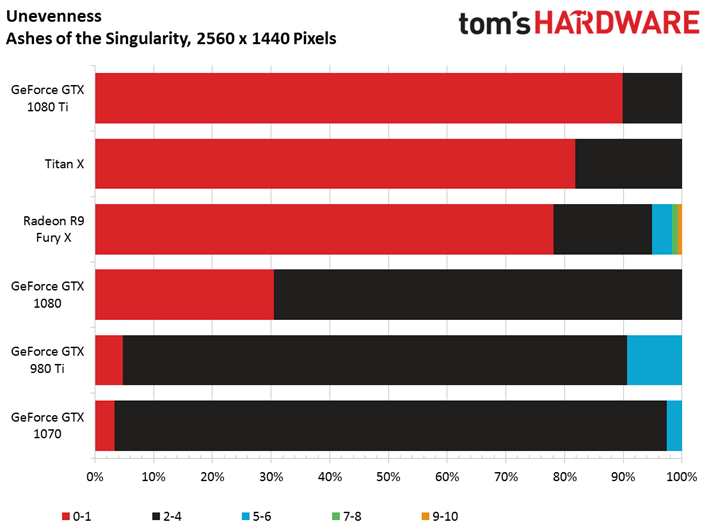
It comes as no surprise that the 1080 Ti performs a lot like Nvidia’s Titan X (Pascal). True to Jen-Hsun’s word, the new flagship is even a little faster at 2560x1440.
AMD’s Radeon R9 Fury X notably beats the GeForce GTX 980 Ti and 1070 in our average frame rate measurements. Paging through the charts, though, you’ll notice its frame times spiking more often than the other cards. The implication of this is reflected in our unevenness metric, where almost 80% of the run is perfectly smooth, but that last 5% or so starts breaking down into less consistent frame delivery.
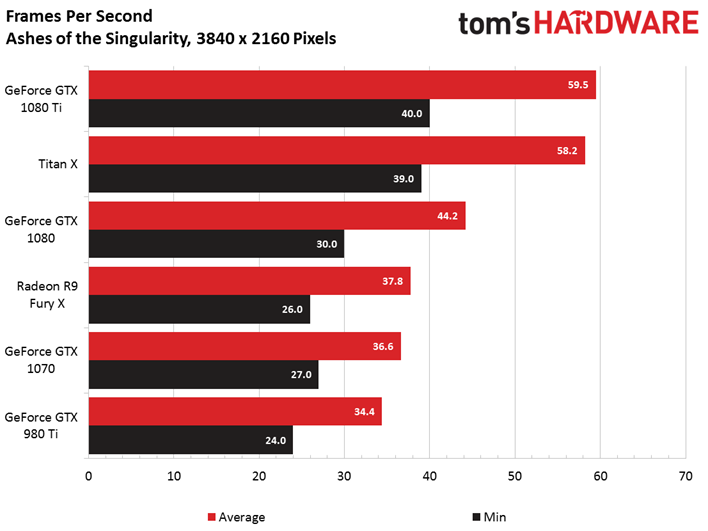
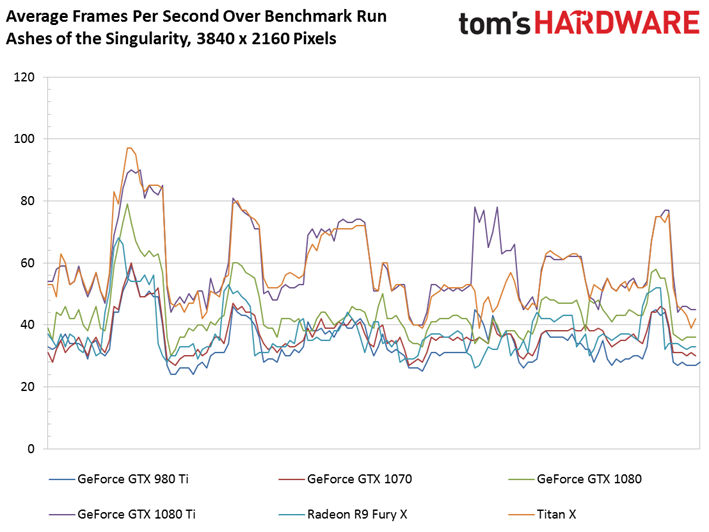
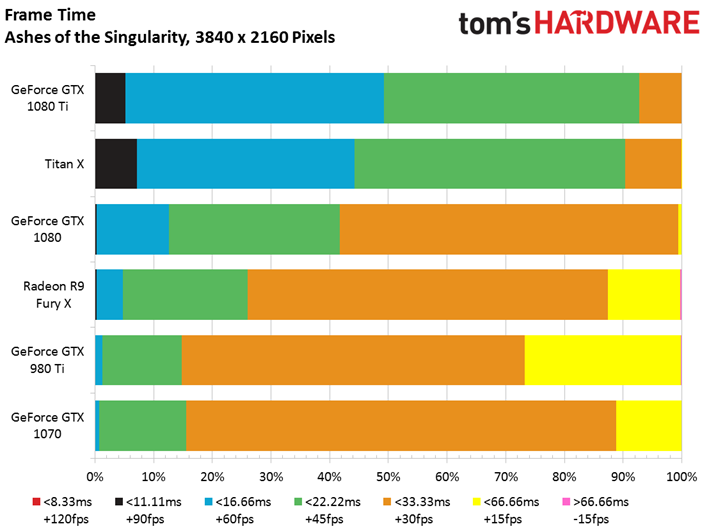
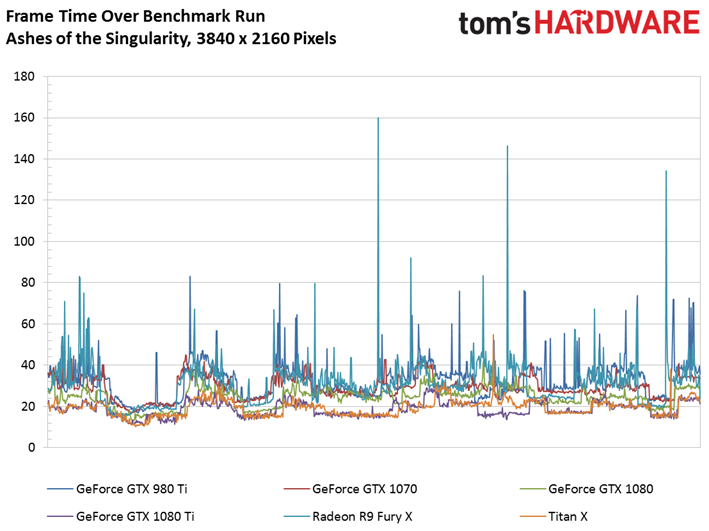
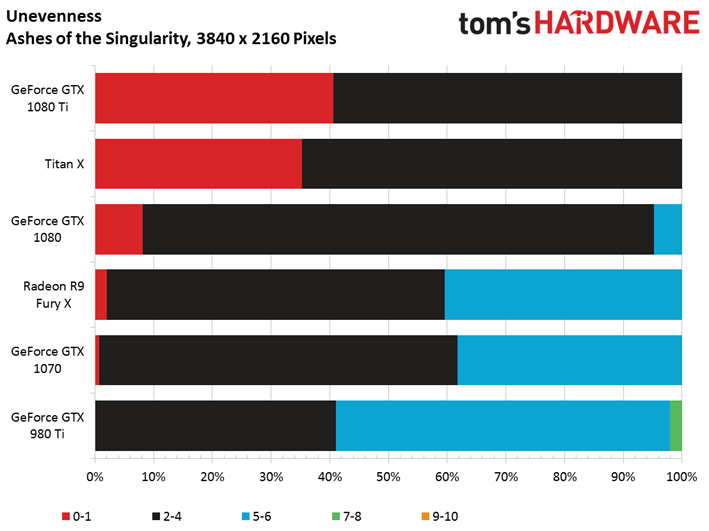
The same finishing order carries over to 4K, where Nvidia’s GeForce GTX 1080 Ti nearly averages 60 FPS and doesn’t drop below 40 FPS.
As before, the Radeon R9 Fury X lands in the middle of our field. While it still demonstrates worrisome frame time spikes, Nvidia’s GeForce GTX 980 Ti seems more prone to stutter according to our unevenness index.
Then again, given the minimum frame rates achieved by the GeForce GTX 1080 and lower, you’d either want to dial quality back in Ashes or upgrade to a faster card for 4K.
Battlefield 1 (DX12)
Our Battlefield 1 benchmark comes from the Avanti Savoia! story, where we run an 80-second sequence at the beginning of O La Vittoria. Naturally, all of our test subjects utilize DirectX 12 and the Ultra quality preset.
Get Tom's Hardware's best news and in-depth reviews, straight to your inbox.
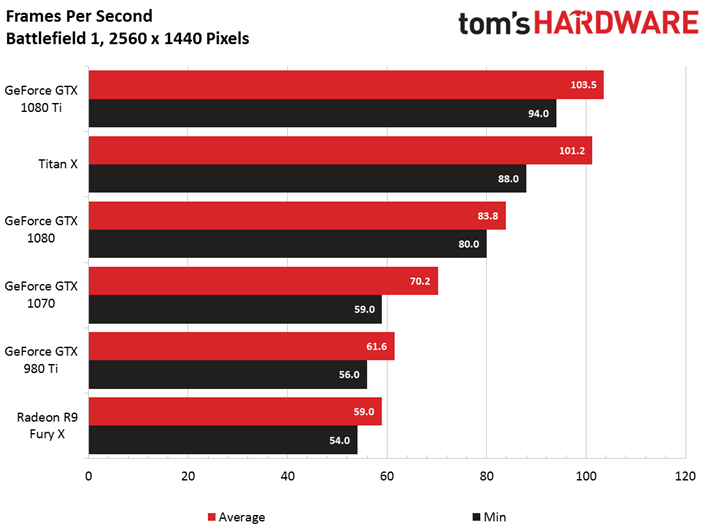
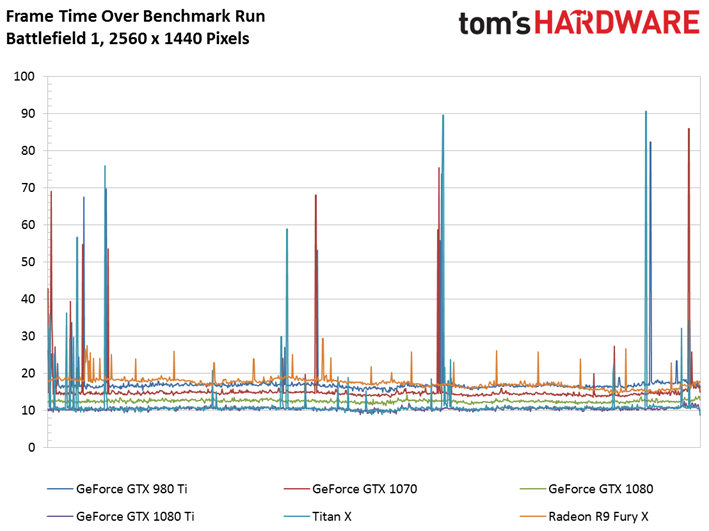
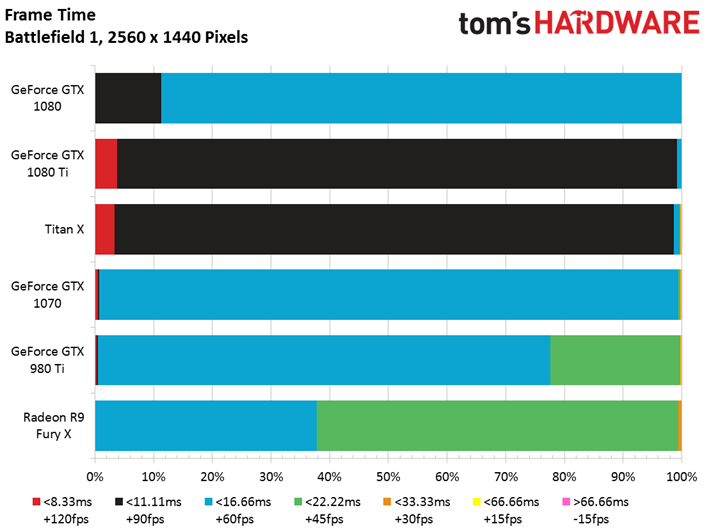
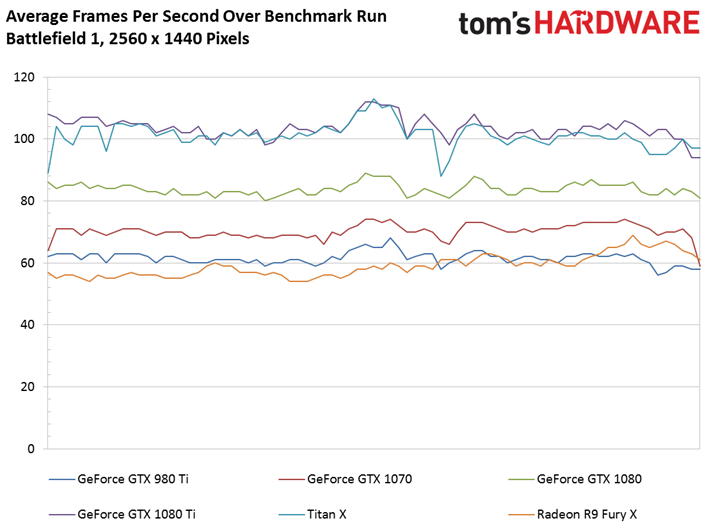
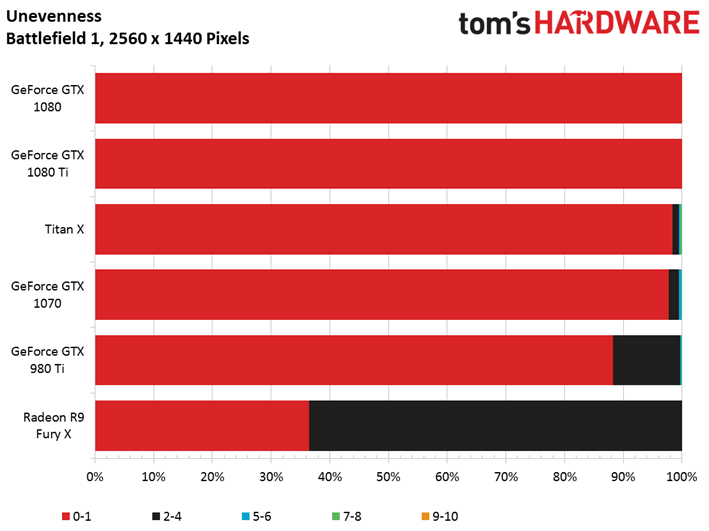
The GeForce GTX 1080 Ti carves out an almost-24% advantage over the GeForce GTX 1080 at 2560x1440, pushing it over 100 FPS on average. That’s a 68% speed-up over last generation’s GeForce GTX 980 Ti. AMD’s fastest single-GPU solution is desperately looking for relief from the Radeon RX Vega, expected next quarter.
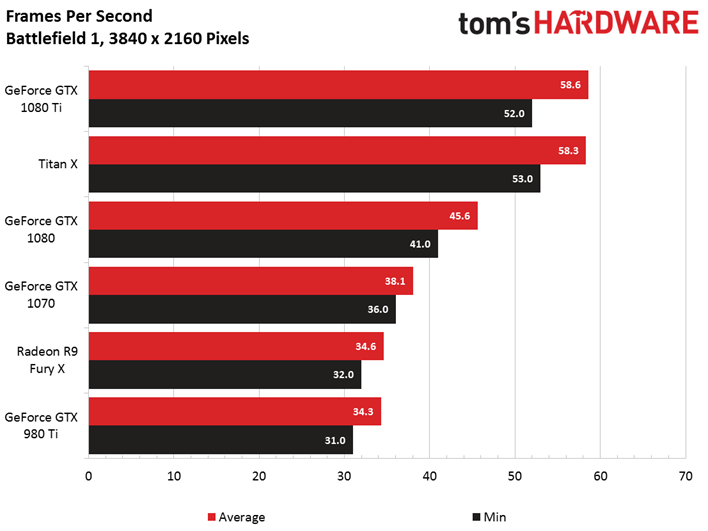
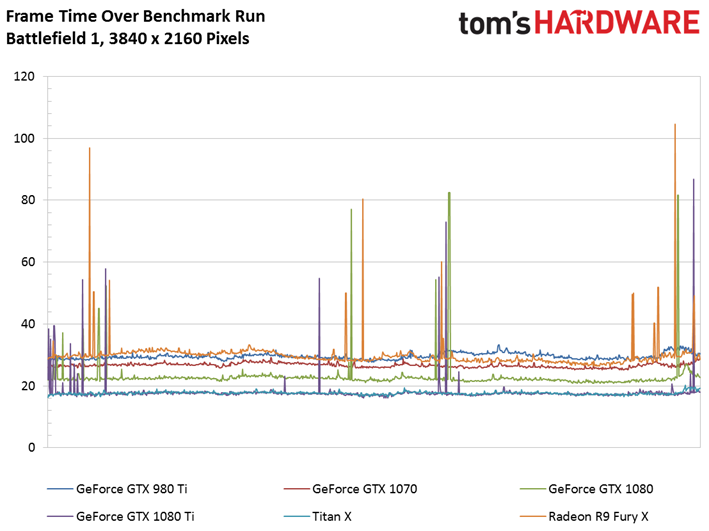
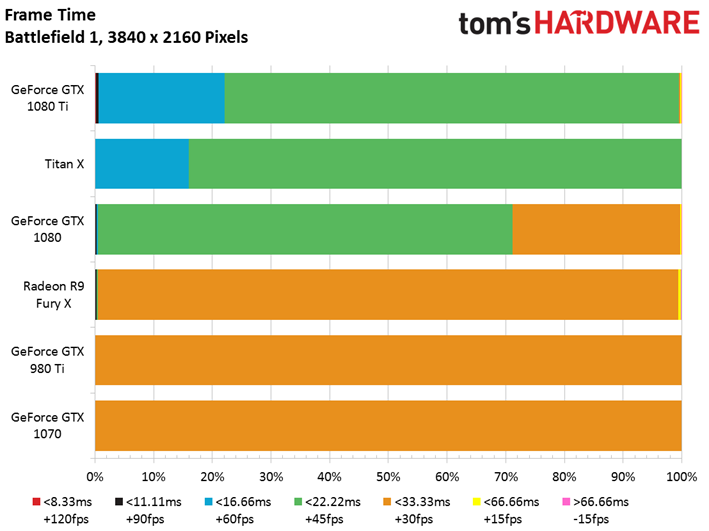
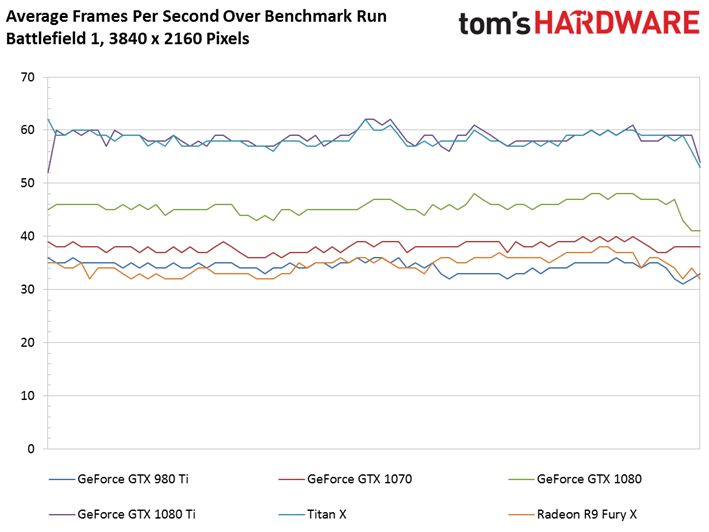
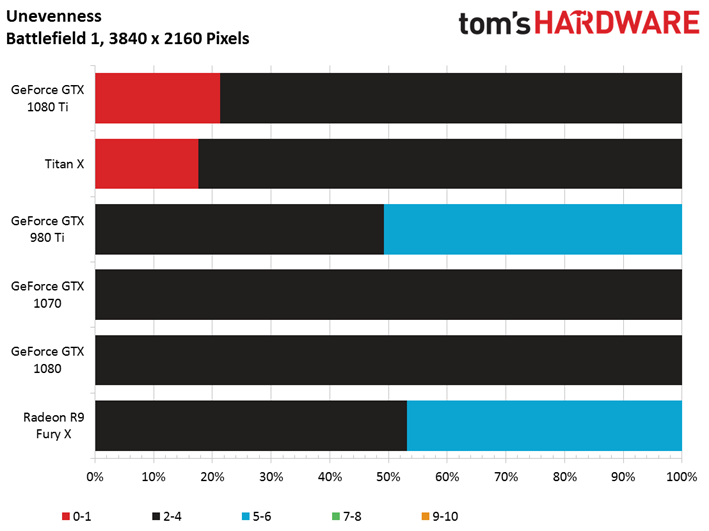
4K is more interesting, if only because the higher resolution puts more of a strain on these high-end graphics cards.
GeForce GTX 1080 Ti maintains a small average frame rate advantage over the Titan X (Pascal), and its lead over GeForce GTX 1080 grows to almost 29%. That’s significant insofar as the 1080 Ti keeps its nose above 50 FPS through our test sequence, while 1080 drops closer to 40 FPS.
Our unevenness index illustrates how the GeForce GTX 1080 Ti and Titan X deliver mostly-smooth experiences, while the GeForce GTX 980 Ti and Radeon R9 Fury X spend about half of the run in an “average” playability range.
MORE: Best Graphics Cards
MORE: Desktop GPU Performance Hierarchy Table
MORE: All Graphics Content
Civilization VI (DX12)
Let’s be real: Civilization VI isn’t great as a graphics benchmark. It’s largely CPU-bound, even on our Core i7-7700K. But we know this is a popular title, so we crank all of the Advanced detail settings up as high as they’ll go and apply 8x MSAA to increase the graphics workload as much as possible.
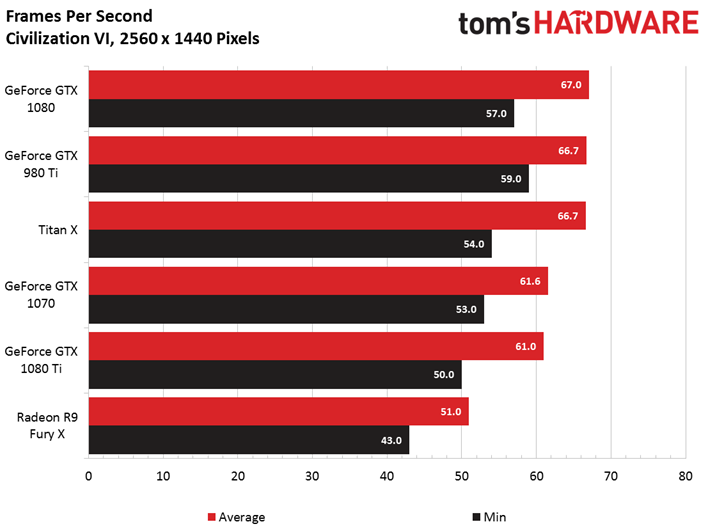
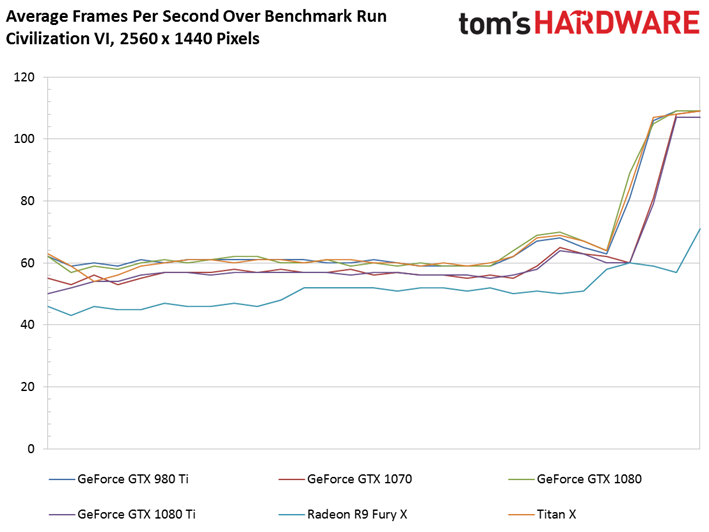
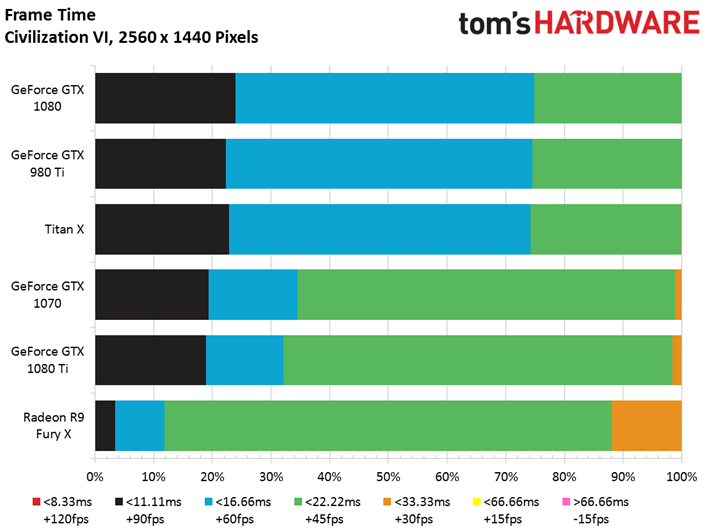
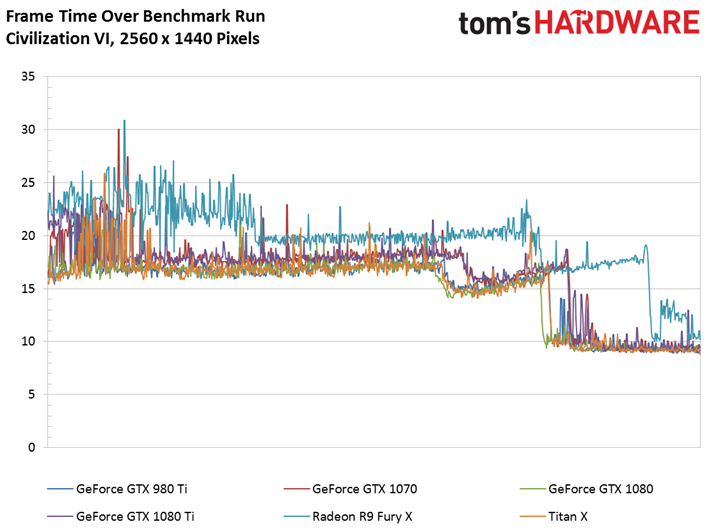
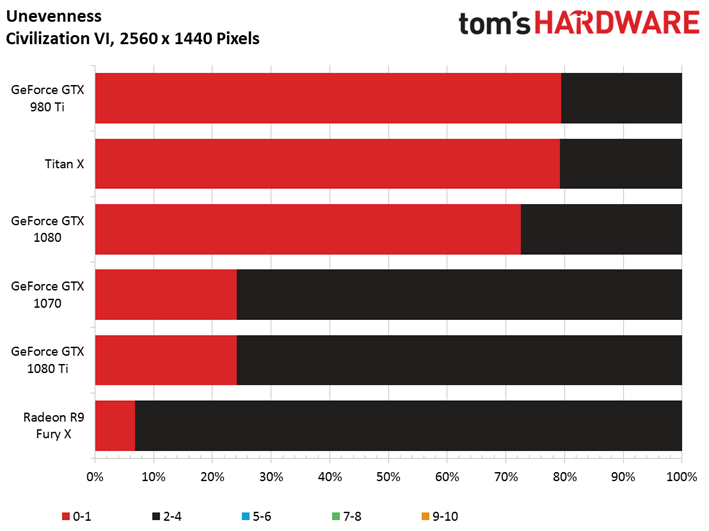
Nevertheless, at 2560x1440, all of the GeForce cards land within a few FPS of each other. The 1080 Ti even appears at the bottom of this pile. Jumping up to 4K should give the GP102-based boards an opportunity to stretch their legs a little more…

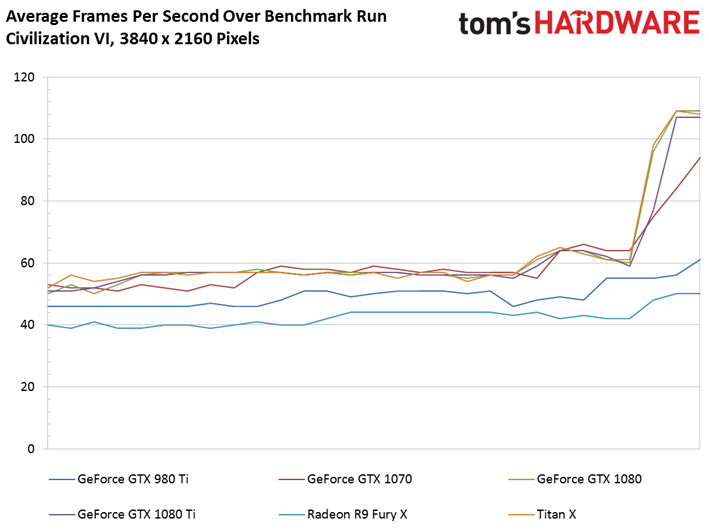
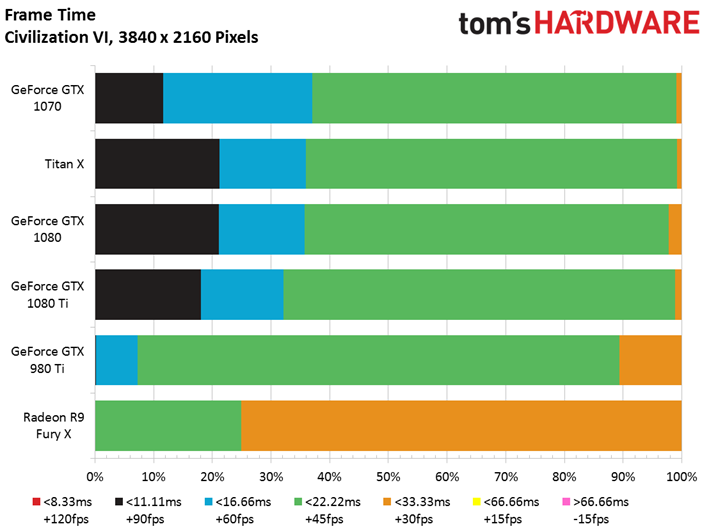
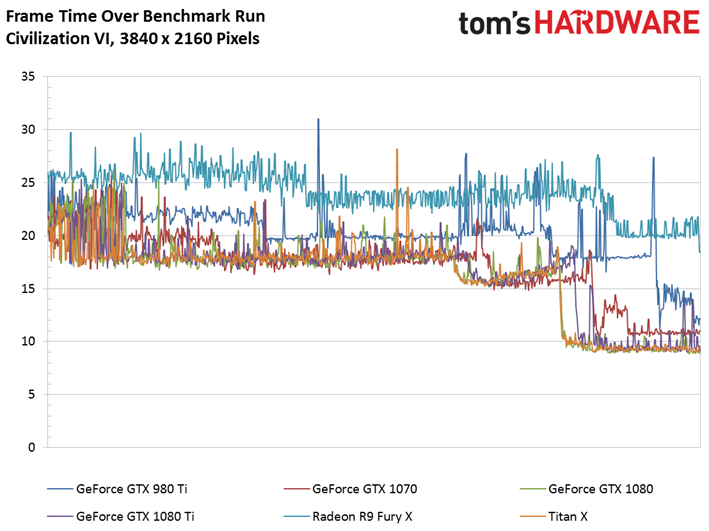
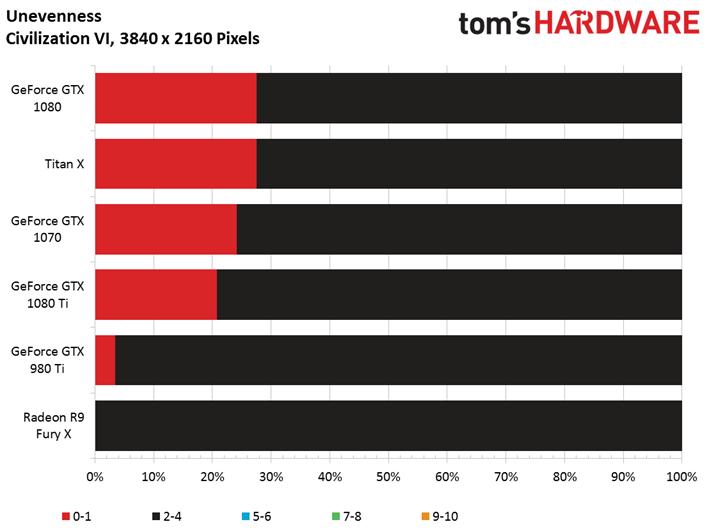
The finishing order straightens out a bit, but the fact that four cards all bunch up around 60 FPS (yes, with v-sync and the game’s internal frame-limiter disabled) tells us more graphics horsepower won’t help. Expect Civ VI to show up more often in our CPU reviews and perhaps mainstream graphics stories. It’s just not a good indicator of high-end GPU performance.
Current page: Ashes, Battlefield 1 & Civilization VI
Prev Page Nvidia GeForce GTX 1080 Ti Review Next Page Doom, GTA V & Hitman-
dstarr3 Oh my. I've got a 980 Ti now, and I thought I could hold out until Christmas 2018 or so to upgrade, but seeing that this card has nearly double the FPS... That's a pretty big deal...Reply -
HaB1971 Would love one, but pointless for 1080p gaming which is what I am restricted to thanks to 2 x 27inch 1080p monitors. I don't need to replace those either they work, they are good enough and not interested in VR etc. 4k for me, is still too priceyReply -
salgado18 Reply19401792 said:Oh my. I've got a 980 Ti now, and I thought I could hold out until Christmas 2018 or so to upgrade, but seeing that this card has nearly double the FPS... That's a pretty big deal...
Why not wait? Your card is still great, and you can pick up a 2080 or Vega 2 by then. Unless you can't live without 4K at Ultra, keep your card. -
Ray_58 Hab1971, 4k really isn't that bad price wise, its ok, part of the problem is the LCD panel industry milking the crap out of 1080p resolutions still up to the 300$ pricepoint when in actuality we should have been at base standard 2k TN/IPS panels at the 160$-300$ range. Still today though the greatest costs are the fact 60htz is still standard and any increase is massive price cost increases, and obviously Gsync for NVidia. Still spending $500-$800 on a monitor and then dropping 700$ on this is a bit 2 much for the mainstream. Id rather buy a 2k IPS screen with Gsync at 700$ than a 4k 60htz monitor at 400$Reply -
envy14tpe Reply19401792 said:Oh my. I've got a 980 Ti now, and I thought I could hold out until Christmas 2018 or so to upgrade, but seeing that this card has nearly double the FPS... That's a pretty big deal...
I feel the same. I see the jump in BF1 to be massive and enough to warrant a 1080 Ti for 1440p gaming. I'm holding out until June when the next Nvidia price drops. -
dstarr3 Reply19401838 said:19401792 said:Oh my. I've got a 980 Ti now, and I thought I could hold out until Christmas 2018 or so to upgrade, but seeing that this card has nearly double the FPS... That's a pretty big deal...
Why not wait? Your card is still great, and you can pick up a 2080 or Vega 2 by then. Unless you can't live without 4K at Ultra, keep your card.
Well, two reasons: 1) I'd like to upgrade to 1440p/144 this year. 2) I also have an HTPC with a 770 in it that needs an upgrade. I was considering buying a 1060 for that computer, but instead, I might just buy this 1080 Ti for my main rig and put its 980 Ti in the HTPC.
Either way, no purchasing until Christmas, because I hate paying full price for just about anything. So I've got time to think about this.
